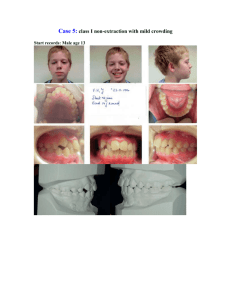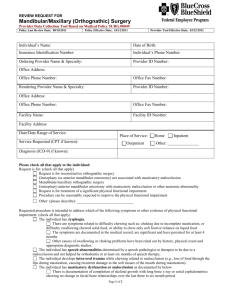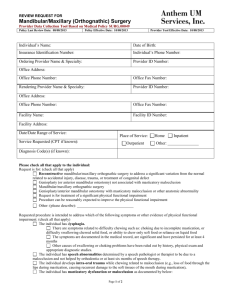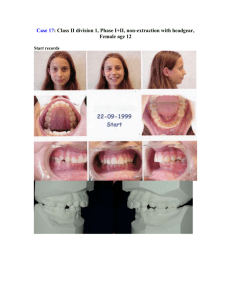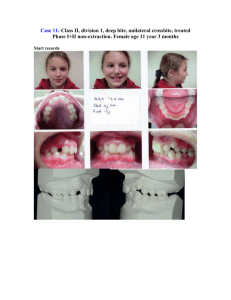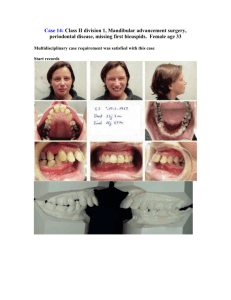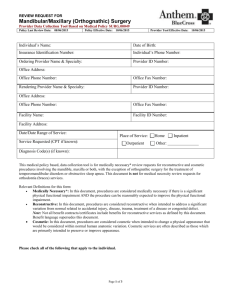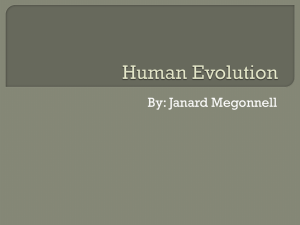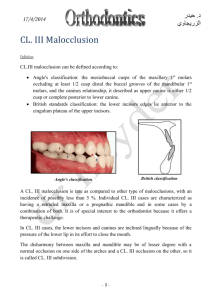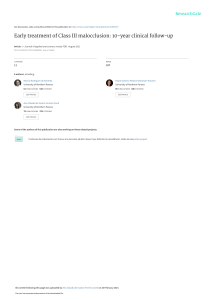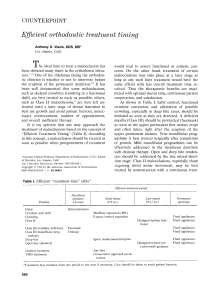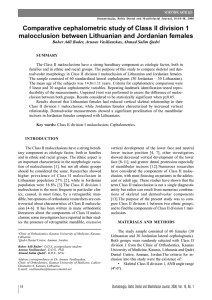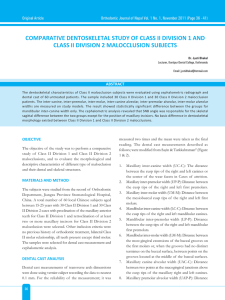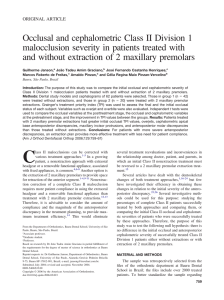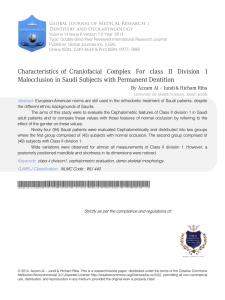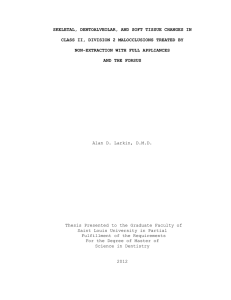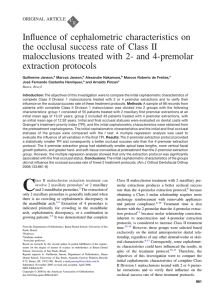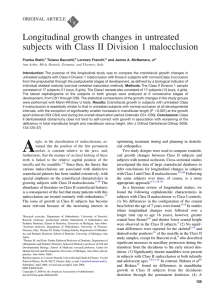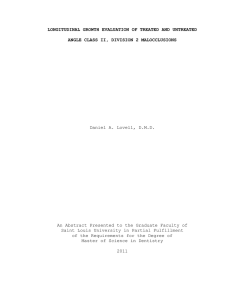nonextraction treatment of an adult with class ii division 2 malocclusion
advertisement
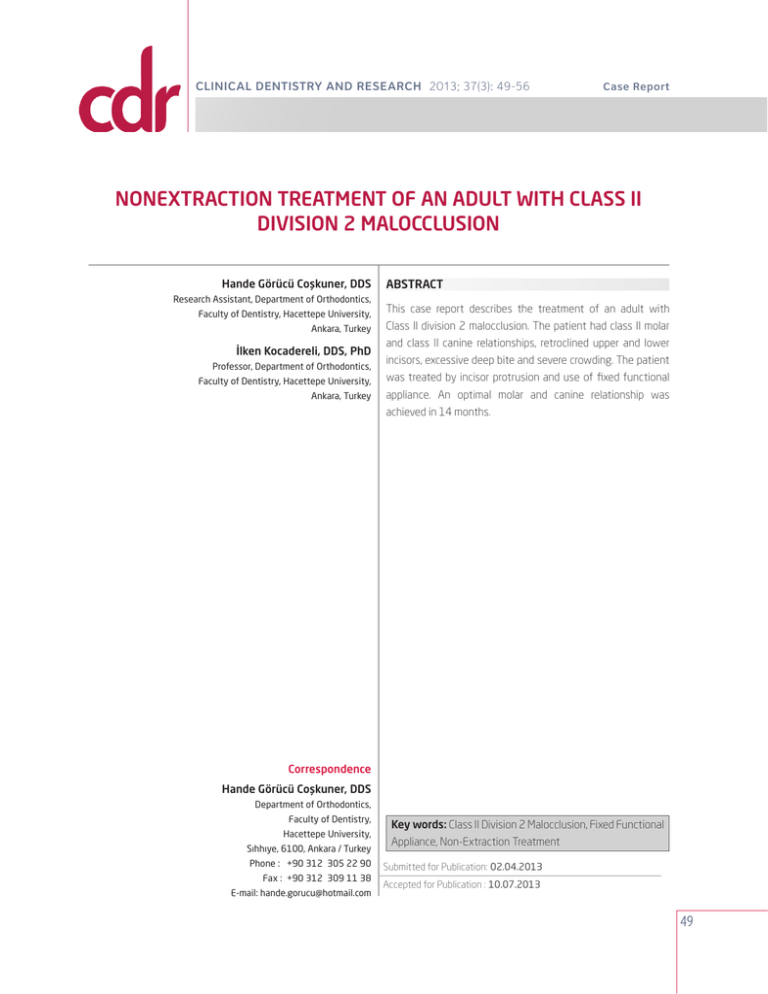
CLINICAL DENTISTRY AND RESEARCH 2013; 37(3): 49-56 Case Report NONEXTRACTION TREATMENT OF AN ADULT WITH CLASS II DIVISION 2 MALOCCLUSION Hande Görücü Coşkuner, DDS Research Assistant, Department of Orthodontics, Faculty of Dentistry, Hacettepe University, Ankara, Turkey İlken Kocadereli, DDS, PhD Professor, Department of Orthodontics, ABSTRACT This case report describes the treatment of an adult with Class II division 2 malocclusion. The patient had class II molar and class II canine relationships, retroclined upper and lower incisors, excessive deep bite and severe crowding. The patient Faculty of Dentistry, Hacettepe University, was treated by incisor protrusion and use of fixed functional Ankara, Turkey appliance. An optimal molar and canine relationship was achieved in 14 months. Correspondence Hande Görücü Coşkuner, DDS Department of Orthodontics, Faculty of Dentistry, Hacettepe University, Sıhhıye, 6100, Ankara / Turkey Phone : +90 312 305 22 90 Fax : +90 312 309 11 38 E-mail: hande.gorucu@hotmail.com Key words: Class II Division 2 Malocclusion, Fixed Functional Appliance, Non-Extraction Treatment Submitted for Publication: 02.04.2013 Accepted for Publication : 10.07.2013 49 CLINICAL DENTISTRY AND RESEARCH 2013; 37(3): 49-56 Olgu Bildirimi SINIF II DİVİZYON 2 MALOKLÜZYONLU BİR ERİŞKİNİN ÇEKİMSİZ TEDAVİSİ Hande Görücü Coşkuner Araştırma Görevlisi, Hacettepe Üniversitesi Diş Hekimliği Fakültesi, Ortodonti Anabilim Dalı, Ankara, Türkiye İlken Kocadereli, Prof. Dr., Hacettepe Üniversitesi, Diş Hekimliği Fakültesi, Ortodonti Anabilim Dalı, Ankara, Türkiye ÖZET Bu olgu raporunda Sınıf II divizyon 2 maloklüzyona sahip erişkin hastanın tedavisi anlatılmaktadır. Hastada sınıf II molar ve sınıf II kanin ilişkisi, dikleşmiş üst ve alt insizörler, aşırı deep bite ve ciddi çapraşıklık bulunmaktaydı . Hastada insizör protrüzyonu ve sabit fonksiyonel aperey ile tedavi yapıldı. Optimum molar ve kanin ilişkisi 14 ayda sağlandı. Sorumlu Yazar Hande Görücü Coşkuner Hacettepe Üniversitesi, Diş Hekimliği Fakültesi, Ortodonti Anabilim Dalı Sıhhiye, 6100, Ankara/Türkiye Telefon: +90 312 305 22 90 Faks: +90 312 309 11 38 e-mail: hande.gorucu@hotmail.com 50 Anahtar Kelimeler: Sınıf II Divizyon 2 Maloklüzyon, Sabit Fonksiyonel Aparey, Çekimsiz Tedavi Yayın Başvuru Tarihi : 04.02.2013 Yayına Kabul Tarihi : 07.10.2013 Treatment Of An Adult With Class II Division 2 Malocclusion INTRODUCTION Epidemiologic investigations have shown that in a population 2-5% of individuals have Class II division 2 malocclusion.1,2 Retrusion of maxillary incisors is one of the main characteristics of class II division 2 malocclusion.3 Therefore, first step in the treatment strategy is to procline the upper incisors by removable plates or protrusion utility arches and converting Class II division 2 to a Class II division 1. Later, class 2 mechanics are used for correction.4 In prepubertal or pubertal period, removable functional appliances can be used but in postpubertal period usually fixed functional appliances are preferred. CASE REPORT 23 year 1 month old white girl referred to Hacettepe University, Faculty of Dentistry, Department of Orthodontics with a chief complaint that she did not like her smile because of the crowding of her anterior teeth. Her medical and dental histories were unremarkable. Extraoral examinations showed concave profile with prominent chin and deep labiomental sulcus. In anteroposterior projection no asymmetry was noticed. Her lips were competent (Figure 1). Intraorally she had class II molar and class II canine relationships in the right and left segments (Figure 2). Mandibular dental midline was centered relative to facial midline but maxillary dental midline was 2 mm deviated to the right of facial midline. The maxillary arch was square shaped with 8 mm crowding (Figure 3). In mandibular arch there was 6 mm crowding in the anterior region (Figure 4). The panoramic x-rays showed no caries and no pathologies. All permanent teeth were present, right maxillary and both mandibular third molars were impacted (Figure 5). Cephalometric examinations showed that both maxilla and mandible were retrusive and mandible was more retrusive with an ANB angle of 6°. Lower anterior facial height was in normal values with 46°. Dentally, both the maxillary and mandibular incisors were retroclined relative to cranial and apical bases and there was excessive deepbite (Figures 6-8). Treatment Objectives Our goals were to improve the patient’s facial esthetics and to provide functional occlusion. According to Ricketts soft tissue analysis, lower lip should be 2 mm behind E line. In our case lower lip was -4 mm to Ricketts E line. To improve Figure 1. Pretreatment facial photographs Figure 2. Pretreatment intraoral photographs 51 CLINICAL DENTISTRY AND RESEARCH Figure 6. Initial cephalometric radiograph Figure 3. Pretreatment maxillary arch Figure 7. Initial cephalometric tracing Figure 4. Pretreatment mandibular arch Figure 5. Initial panoramic radiograph 52 Figure 8. Initial cephalometric tracing-Ricketts Treatment Of An Adult With Class II Division 2 Malocclusion facial esthetics, we should make lips more prominent and therefore, we planned nonextraction treatment strategy. Dental treatment objectives included correction of class II molar and canine relations, correction of deep bite and correction of crowding by protrusion of incisors and expansion of dental arches. During treatment, patient was instructed for extraction of third molars, so all third molars were extracted in finishing phase. For retention; Hawley retainers were placed above upper and lower bonded lingual retainers and the patient was instructed to wear them full time for one year. After one year patient was called for periodic evaluation. Treatment Alternatives Treatment Results First treatment option was mandibular surgery after the extraction of right and left mandibular first premolars for crowding and coordination of dental arches by expansion and upper incisor proclination. Because of prominent chin, after mandibular surgery genioplasty could be necessary. The patient was not willing for surgical treatment. Second treatment option was extraction treatment with the extraction of upper first premolar and lower second premolar. In that case correction of crowding and class II molar canine relationship would be easier but profile of patient would worsen and correction of deep bite would be difficult. In non-extraction treatment crowding can be solved by expansion of the arches and proclination of upper and lower incisors. This would improve esthetics and correction of deep bite would be easier so we decided to apply nonextraction treatment. Favorable facial changes were obtained (Figure 9). Lower lip was forwarded 2 mm according to E plane. Ideal tooth aspect was gained on full smile. Intraorally, deepbite was resolved and ideal overjet and overbite relationships were achieved. Maxillary and mandibular dental midlines were coincident with facial midline and class 1 molar and canine relationships were established (Figures 10, 11,12). Cephalometrically, ANB angle decreased to 4° from 6° and lower anterior facial height changed to 47° from 46°. Upper and lower incisors were proclined relative to cranial and apical bases, and this proclination also helped the correction of deepbite (Figures 13, 14, 15). In final panoramic radiograph, all third molars were extracted (Figure 16). Treatment Progress After evaluation of the diagnostic records; the patient history and the decision of the patient non-extraction orthodontic correction was chosen as the treatment strategy. Expansion was started with the application of a quad-helix appliance. Then, upper incisors were bonded and after leveling with a utility arch, protrusion utility arch was placed which has 45° intrusion bends. Concurrently mandibular teeth were bonded and banded. After upper incisor protraction, upper premolar and canines were bonded. Later, for both upper and lower arches, 0,014 inch Ni-Ti, 0,016 inch Ni-Ti, 0,016x0,016 inch Ni-Ti and 0,016x0,016 stainless steel wires are used respectively. When upper and lower leveling completed, 0.016x0.022 inch stainless steel wires were placed and Forsus Fatigue Resistant Device (3M Unitek 2724 South Peck Road Monrovia, CA 91016 USA) was used. Five months later, Class I molar and canine relationships were achieved. Forsus FRD was removed and for occlusal settling intermaxillary elastics was used. 2 months later, after 14 months from the beginning of treatment, patient was debonded. DISCUSSION Usually, when treating patients who have 6 mm or more crowding in the mandibular arch, we consider extraction. But in the treatment of Class II division 2 malocclusion, extraction would make the correction of deep bite difficult and worsen the profile. In a case report, Asakawa et al.5 treated a girl with Class II division 2 malocclusion who has 8 mm mandibular crowding without extraction. They stated that if the patient was treated with premolar or incisor extraction, proper overjet and overbite couldn’t be obtained. For the reasons mentioned above and to improve facial profile we decided to treat the patient without extraction. After leveling of maxillary and mandibular arches, we corrected Class II molar and canine relationships by using Forsus FRD. One of the main dental effects of Forsus FRD is protrusion and intrusion of mandibular incisors with labial tipping.6,7 In our case both effects are seen and also protrusion and intrusion of mandibular incisors had favorable effect on correction of deepbite. Proclination of lower incisors are considered to be a major factor for gingival recession. In a study, Melsen et al.8 concluded that the risk of periodontal damage secondary to protrusion of incisors is small. Also, Hasund et al.9 noted that mandibular incisors could be proclined more in the patients with hypodivergent skeletal patterns and prominent chins. 53 CLINICAL DENTISTRY AND RESEARCH Figure 9. Posttreatment facial photographs Figure 10.Posttreatment maxillary arch Figure 11.Posttreatment mandibular arch Figure 12.Posttreatment intraoral photographs In treatment of a Class II division 2 female, Asakawa et al.5 also proclined upper and lower incisors significantly, but at the end of the treatment no periodontal damage was noted. By proclination of upper and lower incisors, interincisal angle decreased. In deepbite cases, it is chosen to achieve narrow interincisal angle for stability. Riedel 10 proposed that at the 54 end of treatment, large interincisal angle is associated with relapse of deep overbite. Our treatment lasted in 14 months. If we take a look at treatment durations of Class II division 2 malocclusions, we see prolonged durations. Chen et al.11 treated a 42year old male with Class II division 2 malocclusion, deep Treatment Of An Adult With Class II Division 2 Malocclusion Figure 13.Final cephalometric radiograph Figure 15.Final cephalometric tracing-Ricketts Figure 16.Final panoramic radiograph Figure 14.Final cephalometric tracing overbite and some missing teeth. The total treatment time was 30 months. One of the reasons of excessive treatment duration could be the age of the patient. There are limited publications considering the relationship between treatment duration and patient age.12,13 But in recent articles comparing treatment duration no difference was found between adults and adolescents.14,15 Another reason for prolonged treatment time in that patient could be incisor intrusion for correction of deepbite. In our case by incisor protrusion and using Forsus FRD, deepbite was resolved and no other effort was taken for correction of deepbite. In another case report, 14 year old Class II division 2 female with severe crowding was treated without extraction.5 Treatment duration was 24 months. She also had severe deep bite and deep bite was corrected by incisor intrusion. A 12 year old Class II division 2 male was also treated without extraction and treatment duration was 14 months.16 It was similar with our treatment duration. According to Proffit 17; if Class II traction has proclined the lower incisors more than 2 mm, permanent retention is required. Usually patients are instructed to wear Hawley retainers full time for one year, at night for an additional year and later, return for periodic evaluation.11,16 In our patient we used bonded lingual retainers and Hawley retainers for retention. CONCLUSIONS Correction of Class II malocclusion without extraction was achieved in 14 months. Class I molar and canine 55 CLINICAL DENTISTRY AND RESEARCH relationships were obtained; favorable changes were seen in patient’s profile, smile and aesthetics. Lower lip was forwarded according to E plane so improvement in profile was achieved. Upper arch was expanded and incisors were proclined so patient’s smile was fulled and these results improved her aesthetics. 13. Barrer HG. The adult orthodontic patient . Am J Orthod 1977; 72: 617-640. REFERENCES 14. Robb SI, Sadowsky C, Schneider BJ, BeGole EA. Effectiveness and duration of orthodontic treatment in adults and adolescents. Am J Orthod Dentofacial Orthop 1998; 113: 383-386. 1.Ast DH, Carlos JP, Cons NC. The prevalence and characteristics of malocclusion among senior high school students in upstate New York. Am J Orthod 1965; 51: 437-445. 15. Becker A, Chaushu S. Success rate and duration of orthodontic treatment for adult patients with palatally impacted maxillary canines. Am J Orthod Dentofacial Orthop 2003; 124: 509-514. 2.Ingervall B, Seeman L, Thilander B. Frequency of malocclusion and need of orthodontic treatment in 10-year old children in Gothenburg. Sven Tandlaek Tidskr 1972; 65: 7-21. 16.Ferreira SL. Class II Division 2 deep overbite malocclusion correction with nonextraction therapy and Class II elastics. Am J Orthod Dentofacial Orthop. 1998; 114: 166-175. 3.Bishara SE. Class II Malocclusions: Diagnostic and Clinical Considerations With and Without Treatment. Semin Orthod 2006; 12: 11-24. 17. Proffit WR. Retention. In: Proffit WR, Fields HW Jr, editors. Contemporary orthodontics. St. Louis: Mosby Year Book; 1993. P. 534-535. 4.Von Bremen J, Panscherz H. Efficiency of Class II Division 1 and Class II Division 2 Treatment in Relation to Different Treatment Approaches. Semin Orthod 2003; 9: 87-92. 5.Asakawa S, Al-Musaallam T, Handelman CS. Nonextraction treatment of a Class II deepbite malocclusion with severe mandibular crowding: Visualized treatment objectives for selecting treatment options. Am J Orthod Dentofacial Orthop 2008; 133: 308-316. 6.Aras A, Ada E, Saracoğlu H, Gezer NS, Aras I. Comparison of treatments with the Forsus fatigue resistant device in relation to skeletal maturity: A cephalometric and magnetic resonance imaging study. Am J Orthod Dentofacial Orthop 2011; 140: 616625. 7. Jones G, Buschang PH, Kim KB, Oliver DR. Class II Non-Extraction Patients Treated with the Forsus Fatigue Resistant Device Versus Intermaxillary Elastics. Angle Orthodontist 2008; 78-2: 332-338. 8.Melsen B, Allais D. Factors of importance for the development of dehiscences during labial movement of mandibular incisors: A retrospective study of adult orthodontic patients. Am J Orthod Dentofacial Orthop 2005; 127: 552-561. 9.Hasund A, Ulstein G. The position of incisors in relation to the lines NA and NB in different facial types. Am J Orthod 1970; 57: 1-14. 10. Riedel RA. A review of retrusion problem. Angle Orthod 1960; 30: 179-194. 11. Chen YJ, Yao CCJ, Chang HF. Nonsurgical correction of skeletal deep overbite and Class II Division 2 malocclusion in an adult patient. Am J Orthod Dentofacial Orthop 2004; 126: 371-378. 56 12. Chiappone RC. Special considerations for adult orthodontics. J Clin Orthod 1976; 10: 535-545.
